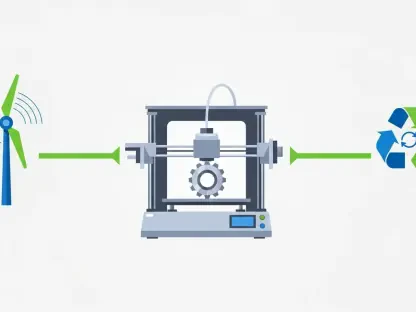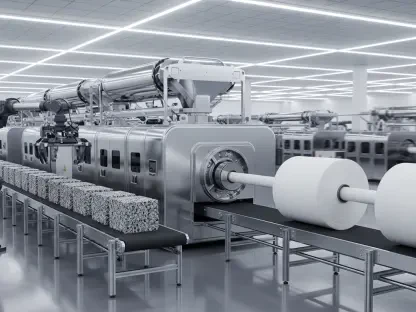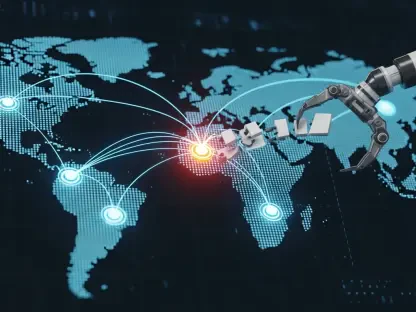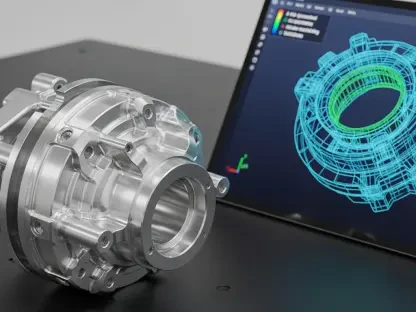The printed circuit board (PCB) industry is experiencing an extraordinary wave of growth, fueled by the skyrocketing demand for high-end PCBs in artificial intelligence (AI) applications, reshaping data centers and advanced electronics. As AI transforms the landscape of high-performance computing, manufacturers face intense pressure to scale up production to meet this unprecedented need. This surge is more than a passing trend; it marks a transformative shift in the tech ecosystem, positioning the PCB sector at the forefront of innovation. With billions of dollars being invested in expansion projects, the stakes are high for companies aiming to secure their foothold in this rapidly evolving market. Yet, alongside the promise of opportunity, there are looming uncertainties tied to the volatile nature of tech investments and AI adoption rates. This dynamic interplay of growth and risk sets the stage for a deeper exploration into how the industry is adapting to the AI revolution, from capacity boosts to technological advancements.
Scaling New Heights in Production Capacity
The relentless demand for AI-driven technologies has sparked a massive push among PCB manufacturers to expand their production capabilities. Leading firms like Vast Sea Technology and Wus Printed Circuit are at the forefront, committing billions in investments to enhance their facilities for producing advanced PCBs specifically designed for AI chips. This isn’t a solo effort; across the globe, numerous companies have unveiled ambitious financing plans, with funds directed toward increasing output for cutting-edge products. The scale of these initiatives is staggering, as the industry collectively aims to address both current needs and future projections. This strategic focus on capacity growth underscores a shared belief in the sustained relevance of AI hardware, positioning these manufacturers to capitalize on a market that shows no signs of slowing down. As projects move from planning to execution, the race to dominate this space intensifies, with each player vying for a larger share of the burgeoning demand.
Beyond the headline-grabbing investments by industry giants, a broader wave of expansion is sweeping through the PCB sector, involving companies of varying sizes. Since mid-2025, multiple firms have announced plans to build new facilities or upgrade existing ones, targeting specialized PCB categories such as High-Density Interconnect (HDI) and High Layer Count (HLC). These efforts are driven by the need to meet stringent performance requirements set by AI applications, which demand precision and reliability in electronic components. The financial commitments are often in the range of billions of dollars, reflecting the high stakes and confidence in long-term growth. This collective momentum signals a transformative period for the industry, as it pivots to align with global technological advancements. However, the rapid pace of expansion also raises questions about market saturation and the ability to balance supply with fluctuating demand, highlighting the delicate tightrope manufacturers must walk in this competitive arena.
AI: The Catalyst for Unprecedented Demand
At the core of the PCB industry’s current boom lies the insatiable appetite for AI technologies, which are redefining the requirements for electronic components. High-performance computing systems and sprawling data centers, critical to AI operations, depend heavily on sophisticated PCBs to support their complex architectures. A striking example is seen in the latest GPU offerings from industry leaders like NVIDIA, where the value of PCBs per unit has surged dramatically, creating a compelling financial incentive for manufacturers to ramp up production. This shift is not merely about meeting volume demands but also about adapting to the specialized needs of AI hardware, which require enhanced capabilities for speed and efficiency. The convergence of AI innovation and PCB manufacturing has thus become a driving force, pushing companies to rethink their strategies and invest heavily in meeting these cutting-edge requirements.
This AI-driven demand extends beyond sheer numbers, fundamentally altering the quality and design of PCBs needed in modern applications. Unlike traditional electronics, AI systems necessitate boards with higher complexity, capable of handling intensive data processing and seamless connectivity. Manufacturers are responding by focusing on high-end products tailored for specific uses in data centers, autonomous vehicles, and advanced communication networks. This pivot toward specialization is reshaping production priorities, as companies allocate resources to develop and produce PCBs that can withstand the rigorous demands of AI workloads. Market analysts anticipate that this trend will continue to accelerate, with AI applications becoming even more integral to global technology infrastructure. The challenge for the industry lies in maintaining this momentum while ensuring that innovation keeps pace with the evolving needs of AI developers, a balancing act that could define the sector’s trajectory for years to come.
Innovation at the Core of PCB Manufacturing
The influence of AI is not only driving demand but also accelerating a wave of technological advancements within the PCB manufacturing landscape. As the requirements for AI hardware grow more stringent, there is a noticeable shift toward producing multilayer boards and other intricate designs that cater to high-performance sectors like communication equipment, automotive electronics, and enterprise servers. Industry forecasts point to significant growth in markets for advanced PCB types, such as HDI, which are expected to see robust expansion over the coming years due to their ability to support denser and more efficient circuit layouts. This evolution reflects a broader industry trend toward embracing complexity, as manufacturers invest in cutting-edge processes to deliver products that meet the exacting standards of modern technology. The push for innovation is reshaping the very foundation of PCB production, setting a new benchmark for quality and performance.
Technological progress in the PCB sector is also evident in the adoption of advanced manufacturing techniques and materials to meet AI-driven specifications. Companies are increasingly integrating automation and precision engineering into their production lines to enhance the reliability and functionality of their boards. This includes refining processes like lamination and etching to achieve finer circuit patterns essential for high-speed data transmission in AI systems. Moreover, there is a growing emphasis on sustainability, with efforts to reduce waste and energy consumption during manufacturing gaining traction. These advancements are critical not only for meeting current market needs but also for positioning the industry to tackle future challenges posed by even more sophisticated AI applications. As technology continues to evolve, the ability of PCB manufacturers to stay ahead of the curve through innovation will be a key determinant of their success in this dynamic and competitive field.
Ripple Effects on the Upstream Supply Chain
The explosive growth in PCB production is creating significant opportunities for upstream suppliers, particularly those providing specialized equipment and materials. As PCB designs become more complex to support AI applications, the demand for high-precision machinery used in processes like exposure, drilling, and electroplating has surged. This trend is fostering a thriving market for equipment manufacturers, with projections indicating substantial growth in this segment over the next few years. Beyond machinery, the need for advanced materials—such as upgraded copper foil and low-dielectric resins—has intensified, as these components are crucial for ensuring high-speed signal transmission and minimal loss in AI hardware. This upstream boom highlights the interconnected nature of the industry, where the success of PCB manufacturers is closely tied to the capabilities of their suppliers, creating a mutually beneficial ecosystem poised for expansion.
However, the reliance on upstream suppliers also introduces potential vulnerabilities into the PCB industry’s growth narrative. While equipment and material providers stand to gain from the increased demand, any delays or shortcomings in innovation could create bottlenecks that hinder downstream production. For instance, the quality of electroplating equipment directly affects the performance of PCBs in terms of integration and signal reliability, making supplier advancements non-negotiable. Analysts have noted that this dependency could pose challenges if supply chain disruptions occur or if technological upgrades fail to keep pace with the rapid evolution of AI needs. Despite these risks, many in the industry remain optimistic, viewing the upstream sector as entering a potential “golden era” of opportunity. The key will be fostering collaboration between manufacturers and suppliers to ensure a steady flow of innovation and resources, safeguarding the momentum of the current expansion wave.
Navigating Risks Amidst the AI Boom
While the prospects for the PCB industry appear bright, there are underlying risks that could temper this enthusiastic growth trajectory. A primary concern is the high correlation between PCB manufacturers and broader technology stocks, particularly those tied to AI development. If capital expenditures in AI slow down due to economic shifts or underperformance of large AI models, the ripple effects could place synchronized pressure on related sectors, including PCBs. This interconnectedness underscores the fragility of the current boom, as external factors beyond the control of individual companies could significantly impact demand. Industry observers caution that while the theoretical benefits of AI architectures are promising, practical implementation challenges remain, potentially stalling commercialization efforts and affecting hardware needs. Balancing aggressive expansion with strategic risk management is thus essential for stakeholders navigating this volatile landscape.
Another layer of uncertainty stems from the pace of AI adoption and the scalability of its applications across industries. Should the rollout of AI technologies encounter delays—whether due to regulatory hurdles, technical limitations, or market hesitancy—the anticipated demand for high-end PCBs could falter. This scenario would challenge manufacturers who have heavily invested in capacity expansion, potentially leading to overproduction and financial strain. Additionally, geopolitical tensions and supply chain disruptions pose further threats, as the global nature of the tech industry makes it susceptible to international dynamics. Despite these concerns, many companies remain committed to their growth plans, banking on the long-term transformative potential of AI. The industry’s ability to adapt to these uncertainties, while maintaining a focus on innovation and efficiency, will likely determine which players emerge as leaders in this high-stakes environment.
Reflecting on a Transformative Era
Looking back, the PCB industry underwent a profound transformation, fueled by the meteoric rise of AI technologies that reshaped the demand for advanced electronic components. Manufacturers responded with unprecedented investments, scaling up production and embracing innovation to meet the needs of data centers and high-performance computing. Upstream suppliers played a pivotal role, stepping up to provide the specialized equipment and materials necessary to support this growth. Despite the challenges and risks that loomed over the sector, the collective drive to capitalize on AI’s potential marked a defining chapter in the industry’s history. Moving forward, the focus should shift to fostering resilience through diversified strategies and stronger supply chain partnerships. Emphasizing sustainable practices and anticipating shifts in AI adoption rates could further solidify the sector’s foundation. As the landscape continues to evolve, staying agile and proactive will be crucial for sustaining the momentum gained during this remarkable period of expansion.









